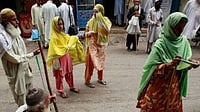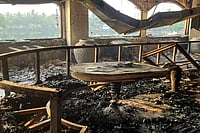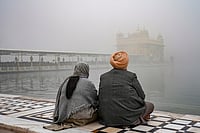The world is accustomed to sabre-rattling Indo-Pak rhetoric but nuclear sabre-rattling is another matter. Alarm bells went off when prime minister Vajpayee reportedly declared at Jalandhar on February 6 that "if they think we will wait for them to drop a bomb and face destruction, they are mistaken". This sounded like a dilution of Indias "no first use" pledge until the authorised government the text the next day said more carefully that "if Pakistan thinks it can destroy India by a nuclear bomb, it is grossly mistaken". On the next day, alarums were intensified when Gen Pervez Musharraf, in his Doordarshan interview, evaded any commitment to "no first use", saying only that "when our national integrity is threatened, well take a decision at that time".
Faced with a steadily worsening climate of Indo-Pakistan relations, President Bill Clinton will be tempted to attempt a mediating role during his visit. Itd be quixotic indeed for him to attempt a quick-fix in South Asia next month after alternately neglecting and mishandling US relations with the region through his presidency. No US mediation in the region is possible unless America removes the distrust that trouble its relations with India. These tensions, rooted in the Cold War US tilt toward Pakistan, have been exacerbated by the sanctions imposed post the Pokhran nuclear tests. The president should use his visit to phase out the sanctions, signal US acceptance of Indian membership in the nuclear club and convey a long-overdue US recognition that its growing economic and military strength make India a major factor in the emerging Asian balance of power.
No effective US mediation is possible unless an elected civilian government replaces the military regime in Pakistan. So long as the armed forces are in control, Islamic extremists will have far greater power than theyve ever had. The ruling military triumvirate is controlled not by its frontman, Gen Musharraf, but by two more powerful generals with long-standing ties to fundamentalists: Lt Gen Mohammed Aziz, chief of general staff, and ISI director Lt Gen Mahmoud Ahmed.
When the generals took over last October, the US made no effort to pin them down to a timetable for a return to civilian rule because it hoped that they would impose bold reforms to forestall an economic collapse there. But on key reform issues, such as tax collections, the triumvirate has dithered. The economic situation continues to deteriorate and the regime is silencing potential critics.
Even with a return to civilian rule, the road back to Lahore would be a rocky one. But the outlines of a possible Kashmir settlement are visible. The cornerstone of such a resolution would be mutual Indian and Pakistani recognition of the LoC as the permanent boundary. This would be accompanied by the termination of Pakistani support for the insurgency in Kashmir and the gradual reduction of the forces that both sides now deploy in Kashmir. But such a settlement would not be possible until both India and Pakistan negotiate autonomy agreements with the Kashmiris under their control.
India, in particular, would have to show a new sensitivity to Kashmiri aspirations to soften the bitterness left by its brutal repression of the insurgency. As the war drags on, sentiment seems to be growing for autonomous status within Indias Constitution as the only realistic way to end the bloodshed-but if, and only if, New Delhi is ready to grant enough autonomy.
The most important step that India could take to begin defusing tensions with Pakistan would be to undercut political support for the insurgency in the Valley and strengthen moderate elements there by spelling out meaningful proposals for increased autonomy. Many of the autonomy demands made by chief minister Farooq Abdullah would have to be part of such proposals in order to cut through the bitterness left from a decade of fighting.
The argument made against Kashmir autonomy proposals has always been that India cannot give its only Muslim-majority state a degree of autonomy not enjoyed by other Indian states. My answer has been that autonomy for Kashmir could be folded into an overall restructuring of the Indian federal system in which all states would get greater power. This has sounded fanciful in earlier decades when a single majority party governed at the Centre. But the dispersion of power to regionally-based parties reflected in the present BJP-led coalition has changed the situation and the BJP itself has long opposed the existing degree of centralisation. The advocacy of a looser federal system by Andhra Pradesh chief minister Chandrababu Naidu, a key figure in the BJP-led National Democratic Alliance, coupled with the pending increase in the proportion of central tax revenues to be allocated to the states, shows which way the wind is blowing.
In addition to projecting a new flexibility with respect to autonomy, India could offer to break up the existing Jammu and Kashmir state as part of a settlement. Jammu and Ladakh could be incorporated into India and the Kashmir Valley split off as a separate entity. It is this new, truncated Kashmir state that would then receive increased autonomy.
Since the LoC would have to be the basis for a settlement, it was regrettable that Vajpayee in his February 2 speech declared categorically that "we will not rest until the remaining part of Kashmir is secured". In the future, the less said about recapturing "Azad" Kashmir the better. Apart from the danger involved in ever-escalating tensions, itd be more difficult to accept the LoC as the permanent international boundary if rhetoric like the February 2 statement becomes standard.
Clinton could help to pave the way for an eventual settlement by publicly declaring US support for the LoC as the permanent boundary. This would make it clear to Pakistan that it will gain nothing by keeping the pot boiling in Kashmir. But the focus of his visit to New Delhi should be on removing the psychological barriers that obstruct close cooperation between India and the US both regionally and globally. Above all, this would require bold steps to resolve nuclear tensions and signal US acceptance of India as a major power.
Clinton is likely to push New Delhi both to sign the CTBT and to pledge that it will not deploy operational nuclear weapons in the field. At the same time, hes decided to keep economic sanctions in force and it isnt clear whether they would all be removed even if India signs the test ban. The US has conducted 949 nuclear tests, maintains an arsenal of 10,000 nuclear weapons and is not even willing to go as far as Russia is in reducing their respective nuclear stockpiles. In this background, India and Pakistan understandably regard the US imposition of sanctions as hypocritical and arrogant. India could justifiably insist on the simultaneous removal of all sanctions as its condition for signing the test ban.
If the White House wants to move toward the resolution of its nuclear tensions with New Delhi, it could do so in two ways. First, Clinton could relax restrictions on the sale of US civilian nuclear technology in return for a bilateral or multilateral commitment thatd formalise Indias policy of not exporting nuclear technology. Second, he could put India on a par with China in his address to Parliament.
A new US South Asia policy that gives India its deserved priority as a power eight times larger than Pakistan would help stabilise the area by showing Pakistan the futility of its present spoilers role, especially if the US declared its support for the LoC as the basis for a settlement in Kashmir. Regrettably, based on my conversations with US officials, I see little possibility that this will happen during the denouement of the Clinton administration. It will be up to India, then, to do on its own what is necessary to avoid a war.
My own hope is that India will maintain a restrained military posture, resisting the temptation to stage cross-border forays; to open a second front outside Kashmir; and to destabilise or dismember Pakistan. The restraint demonstrated by India during Kargil consolidated world opinion on Indias side and New Delhis task is to keep the onus on Pakistan as the disturber of the peace. Sooner or later, the military dictatorship in Pakistan will end and new opportunities for talking peace with Pakistan will then open up once again-if, in that time, India couples its military resolve in Kashmir with a new readiness to negotiate a workable political accommodation with representative Kashmiri leaders.



















_.jpg?w=200&auto=format%2Ccompress&fit=max)






